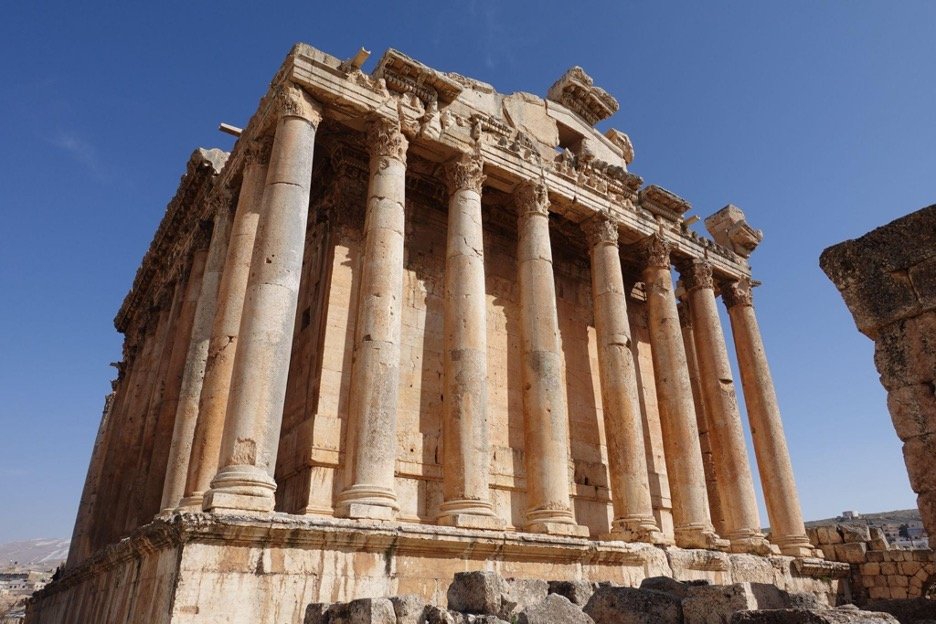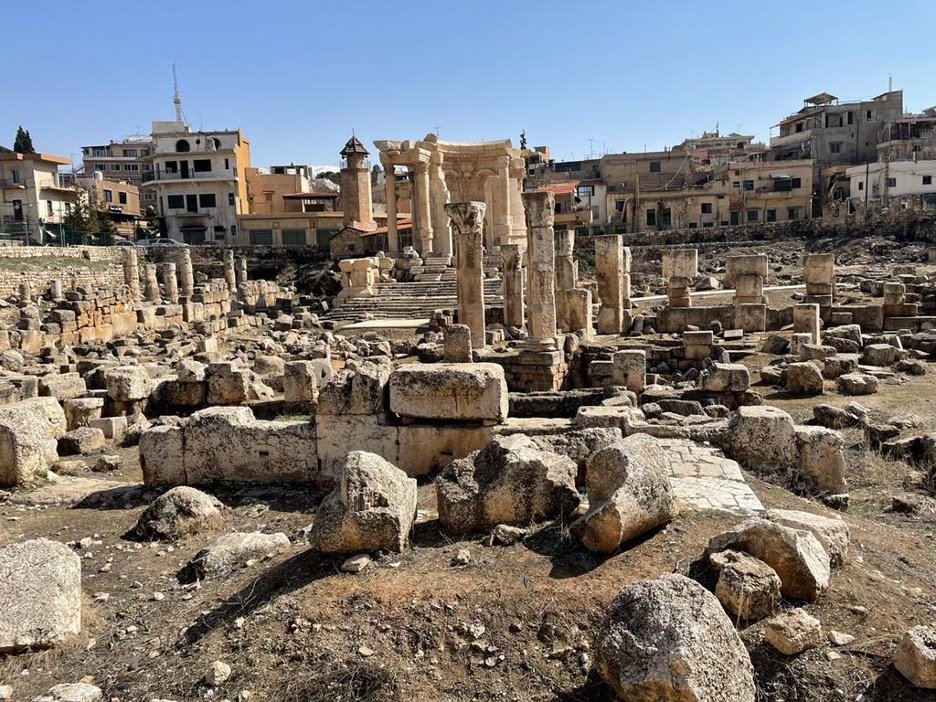Overview of Baalbek
By Grace Landsberg
Baalbek is a modern city in the eastern part of Lebanon, close to the Syrian border in the Beqaa Valley. Only 67 kilometers from Beirut, Baalbek holds some of the most spectacular and well-preserved Roman ruins in the world. It is one of the oldest constantly inhabited sites, first inhabited by the Phoenicians as early as 9000 BCE. The entire campus was built over a period of over two centuries, where Mesopotamian, Roman, Christian, and Islamic groups all came to the sacred site and introduced their own influences to the structures and architecture. The site consists of three major temples: the Temple of Jupiter, the Temple of Bacchus, and the Temple of Venus [i]. How exactly these temples were built remains a historical mystery: each one of the foundation stones for the Temple of Jupiter weighs about one-thousand tons--comparatively, the blocks at Stonehenge are on average about 25 tons.
As a tremendously old archaeological site, the entity in control of the location has changed several times. There is very little known about Baalbek before the Greek conquest of Syria in 332 BCE. Archaeological excavations under the Temple of Jupiter have uncovered traces of settlements dating to the Middle Bronze Age (1900-1600 BC) that were apparently built on top of an even older layer of human habitation dating to the Early Bronze Age (2900-2300 BCE). There are Bible passages that mention a place in connection with the King of Solomon called Baalath, but historians are hesitant to equate Baalath with Baalbek. For such enormous and important monuments, there is hardly any ancient documentation about Baalbek. After the time of Solomon, the Phoenicians then took control of Syria and chose Baalbek as a worship site [ii].
The temple of Jupiter, with the temple of Bacchus seen in the background.
Alexander the Great, king of the ancient Greek kingdom of Macedon, conquered the city in 332 BCE and renamed it Heliopolis, 'City of the Sun.’ After Alexander the Great’s death in 323 BCE, the region became under the control of the Ptolemaic Dynasty of Egypt during the Hellenistic period. In 200 BCE it was conquered by the Seleucid Antiochus III (the Great) and remained under the control of the Seleucid Dynasty until the fall in 64 BCE, after which time it came under control of the Romans. A few decades later the site became a Roman colony in around 15 BCE. During the Byzantine period, the site avoided demolition by being used as a Christian church of worship. After the control of the Byzantine Empire, Baalbek came under Arab domination in 637 CE [iii]. From this point up until the 20th century, the sacred site was governed by the various Muslim rulers of Syria. The Ottoman Empire largely ignored the site and it was not until 1898 CE when the German Emperor Wilhelm II commissioned a team of archaeologists that restoration work began. After World War I and the collapse of the Ottoman Empire, the League of Nations mandated the five provinces that make up present-day Lebanon, and Baalbek was included [iv].
The Temple of Bacchus.
The name Baalbek means “Lord Baal of the Beqaa Valley,” for the center of the campus was originally a temple to Astarte, the Queen of Heaven and Baal the sky-god. Later, when the Romans came to the site, they built on top of this temple and dedicated it as a Temple to Jupiter Baal. Built on top of a previously constructed foundation, the Temple to Jupiter became the focal point of the campus atop the hill. Only portions of this Temple remain, most notably the 6 Corinthian columns where one can see the massive Temple to Bacchus below and behind it. For perspective, these columns are 19.9 meters high (65 feet), a full 8 meters taller than the columns at the porch of the Pantheon which are 11.8 (39 feet tall).
The temple of Bacchus is the largest structure on the site and is one of the most well-preserved Roman ruins in the world. Carvings of animals such as lions, bulls, and eagles can still be seen clearly on the architecture. The construction of this particular temple was commissioned by Roman Emperor Antoninus Pius. The gigantic dimensions of this temple are what attract most to the site.
The temple of Venus.
The Temple of Venus, also known as the Round Temple, stands slightly apart from the Temples of Jupiter and Bacchus in both physical location and size. The Temple of Venus is known for the harmony of its structure rather than its grandiose stature. The ornamental carvings of seashells and doves are part of what indicates to historians that the Temple was dedicated to a feminine figure. During Byzantine times, the Temple was converted to a place of Christian worship for Saint Barbara [v].
The site has thankfully mostly avoided destruction from nearby conflicts due to the efforts of national and international governing bodies. It was named a UNESCO World Heritage Site in 1984 and attracts thousands of visitors every year. The site, like most of the country, was closed off to tourism during the Lebanese Civil War (1975-1990) for some years. Today, the Lebanese state sponsors events hosted at the sites such as fashion shows, exhibitions, and music festivals [vi].
Citations:
[i] Ghali, M. (2019, July 11). Mystery Of the Stones: How Lebanon’s Baalbek Ruins Are a Site for the Gods. Middle East Eye. https://www.middleeasteye.net/discover/baalbek-lebanon-ruins-tour.
[ii] Building Stonehenge. (n.d.). English Heritage. https://www.english-heritage.org.uk/visit/places/stonehenge/history-and-stories/building-stonehenge/#:~:text=On%20average%20the%20sarsens%20weigh,the%20smaller%20stones%20at%20Stonehenge.
[iii] Mark, J. J. (2016, December 1). Baalbek - World History Encyclopedia. World History Encyclopedia. https://www.worldhistory.org/Baalbek/#:~:text=Inhabited%20as%20early%20as%209000,Baal%20of%20the%20Beqaa%20Valley).
[iv] T. (2021, November 11). Baalbek | Lebanon, Temples, & Festival. Encyclopedia Britannica. https://www.britannica.com/place/Baalbeck#ref127742.
[v] Gray, M. (n.d.). Baalbek. Sacred Sites: World Pilgrimage Guide. https://sacredsites.com/middle_east/lebanon/baalbek.html.
[vi] Heritage Centre, U. W. (2017, May 12). Baalbek - UNESCO World Heritage Centre. Baalbek - UNESCO World Heritage Centre. https://whc.unesco.org/en/list/294/.



